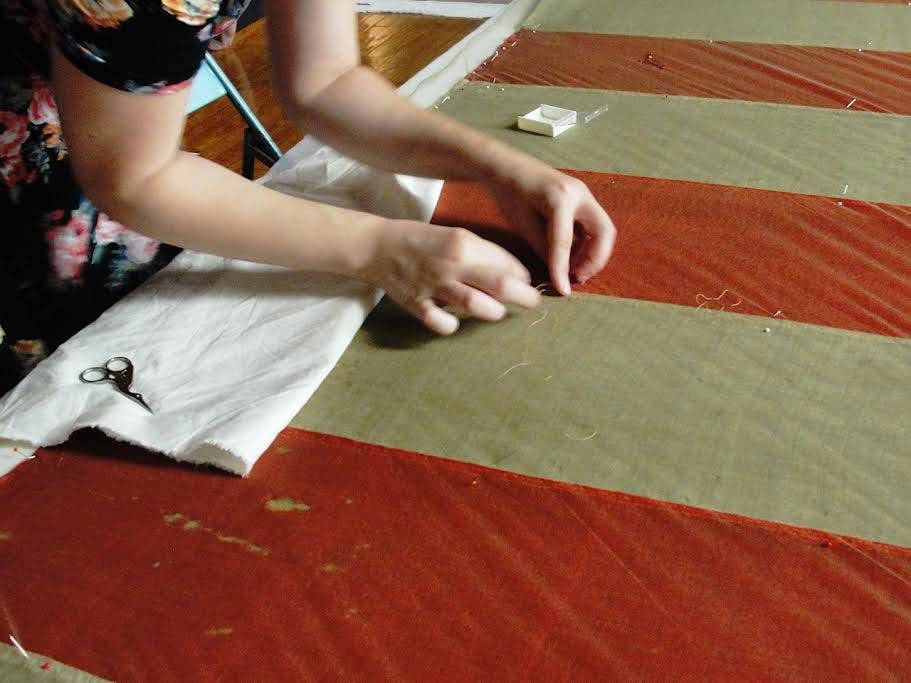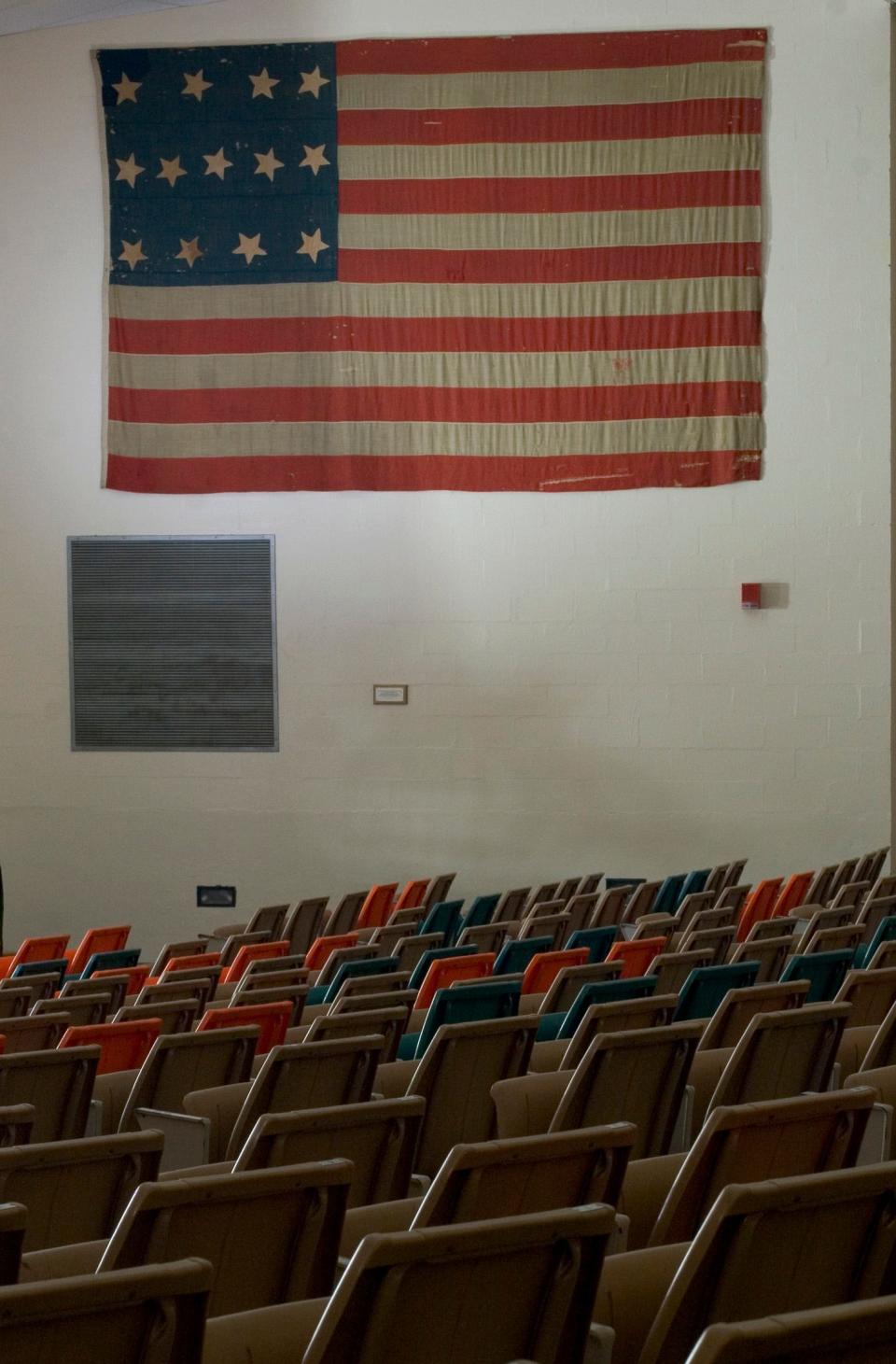Great-great-grandchildren of 1860s Dennis sea captain hope to save antique flag. How?
After 53 years, Capt. Bernard O’Neil’s 13-star United States flag is looking for a new home.
O’Neil was a 19th-century merchant sea captain who lived his adult life in West Dennis.
The flag, dated sometime in the 1860s, was often flown on O’Neil’s ships and was donated to the Nathaniel H. Wixon Innovation School in 1970 by the captain’s three granddaughters, Ruth Cipkowski, Mary Ann Savery and Josephine Clarke, said Peter Cipkowski, Ruth’s son.
Now that the Wixon School has been closed since the end of February, when both Wixon and Mattacheese students moved to Station Avenue in South Yarmouth, Peter Cipkowski and his cousin Terri Clarke Williams, both great-great-grandchildren of the captain, have become concerned about the future of the historic flag.

“It could be lost; that’s my concern,” Cipkowski said, of the flag, displayed in an abandoned school building. “It would be tragic if it ended up in a dumpster.”
The flag serves as a backdrop to town meetings, which are held at Wixon, and building security remains the same as when the school was open. The town is considering uses for the school, Diane Rochelle, Chairperson of the Dennis Historical Commission wrote in an email, with a Request for Expression of Interest (RFEI) seeking someone interested in the property due June 2.
“We just want it to be where it will be appreciated, not put in a box to be forgotten,” said Williams.
Rochelle said that at a March 14 government meeting the flag was considered “an important asset."
Who was Captain Bernard O'Neil?
Prior to its being donated to the Wixon School in Dennis, the flag was stored at O’Neil’s house on Fisk Street in West Dennis.
“I was always curious about it, and it was only occasionally unfolded because of the delicate condition of the flag,” said Cipkowski, who distinctly remembered seeing the flag, which was once flown at the house, as a young boy.
O’Neil moved to Dennis, where he built the house, around 1845 when he married his first wife, Cipkowski said. After two more marriages and a lifetime as a merchant sea captain, O’Neil died in 1889.
The family kept the house and the flag until 1970 when Ira Bernard O’Neil, Cipkowski’s great-grandfather passed away.
The huge, 10-feet by 15-feet captain's flag arrives at Wixon School, then is restored.
That’s when the flag was donated to the Wixon School.
In 2014, the flag was restored “thanks to generous funding by the Community Preservation Act; the flag was conserved by Museum Textile Services for $45,000.00,” said Rochelle in an email.
In 2015, a rededication ceremony was held at the Wixon School, and Cipkowski, who is considered the family historian, gave a presentation.
It is a huge 10-foot by 15-foot flag and continued to hang at the Wixon School since the restoration.

Was Capt. O'Neil an abolitionist who smuggled slaves from the Confederacy?
In addition to being historically significant as a family heirloom to the descendants of O’Neil (although it is officially the property of the town of Dennis), it is historically significant.
In family lore, O’Neil, who was an abolitionist, used his merchant vessels to smuggle slaves from the Confederacy, although Cipkowski said there is no official documentation that this was the case.
In addition, the flag is a symbol for the family of the captain’s legacy as a seaman.
Cipkowski is very proud to note that his great-great-grandfather was a member of The Boston Marine Society, which he said was founded in 1742 and is the oldest association of sea captains in the world. Other members include John Adams, who became the 234th member in 1769 and Franklin D. Roosevelt, who became member number 2,590 in 1933.
Cipkowski thought that the 13-star flag, even though the Union was comprised of 38 states and the United States flag had 38 stars on it, was to antagonize the Confederacy.
What's the history of 13-star American flags?
Jeff R. Bridgman of Antiques Inc. who is a collector and seller of antique flags and as such is also a flag historian, said this was very unlikely and that the Confederacy also flew 13-star flags.
A truer explanation, Bridgman said, is that there were many 13-star flags used in the mid-1800s, especially on ships, because the stars could be seen better if there were fewer of them on the blue field.
Rochelle’s research is consistent with Bridgman’s explanation.
She said that the flag was handsewn around 1860, and that the company of Pollard, Leighton and Co., located at 104 Tremont Street in Boston made flags like the one O’Neil had.
The 13 stars are in a very specific configuration of three rows with four stars, then five, then four on the blue field with seven red stripes and six white stripes.
“It is possible that the ship’s flag was made here for O’Neil to fly from the parade deck of his ship during the Civil War as he entered foreign ports,” said Rochelle.
In turn, Bridgman’s research supports that of Rochelle.
“This is a huge flag. It may be a ship’s flag. It is probably not U.S. Navy. I can’t see the stitching well, but I can’t see the fabric well enough to say that this is almost certainly a mid-19th century example,” said Bridgman in an email after seeing photos of the flag.
Though maybe not part of the underground railroad, it is true that O’Neil did some merchant shipping in and around Confederate waters.
In Cipkowski’s presentation at the flag’s rededication at the Wixon School in 2015, he presents evidence that one of O’Neil’s ships, The Sea Lark, was sunk by the Confederacy on May 3, 1863.
Decisions by the town of Dennis as to the eventual fate of the flag are still pending.
Thanks to our subscribers, who help make this coverage possible. If you are not a subscriber, please consider supporting quality local journalism with a Cape Cod Times subscription. Here are our subscription plans.
This article originally appeared on Cape Cod Times: Saving the antique, 13-star flag at an abandoned West Dennis school

